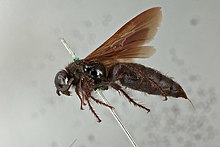
The Scoliidae, the scoliid wasps, are a family of about 560 species found worldwide. They tend to be black, often marked with yellow or orange, and their wing tips are distinctively corrugated. Males are more slender and elongated than females, with significantly longer antennae, but the sexual dimorphism is not as apparent as in the Tiphiidae.

Sir James Edward Smith was an English botanist and founder of the Linnean Society.

Erik Acharius was a Swedish botanist who pioneered the taxonomy of lichens and is known as the "father of lichenology." Acharius was famously the last pupil of Carl Linnaeus.

Domenico Maria Leone Cirillo was an Italian physician, entomologist, botanist and patriot of the Neapolitan Republic of 1799.

The black-faced munia is a species of estrildid finch found in Indonesia and East Timor. It occurs in a wide range of habitats including artificial landscapes, forest, grassland and savannah. It was first described by the Swedish naturalist Carl Linnaeus in the twelfth edition of his Systema Naturae in 1766. The IUCN has evaluated the status of this bird as being of least concern.

The blue-spotted wood dove is a species of bird in the family Columbidae. It is abundantly present throughout Africa south of the Sahel; it is partially present in East Africa and absent in southern Africa.

The Caribbean elaenia is a species of bird in the family Tyrannidae found in the West Indies and parts of Central America. Its natural habitats are tropical and subtropical dry broadleaf forest, subtropical or tropical moist lowland forest, and heavily degraded former forest.
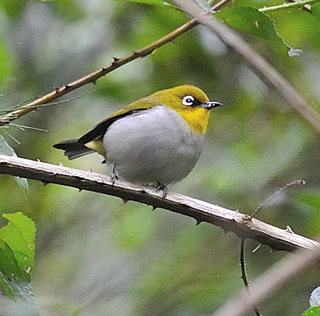
The Malagasy white-eye is a species of bird in the white-eye family, Zosteropidae. Found in Madagascar and Seychelles, its natural habitats are subtropical or tropical dry forests, subtropical or tropical moist lowland forests, subtropical or tropical mangrove forests, and subtropical or tropical moist montane forests.

The Réunion olive white-eye is a species of bird in the family Zosteropidae. It is found on Réunion. Its natural habitats are boreal forests and subtropical or tropical high-altitude grassland.

A wasp is any insect of the narrow-waisted suborder Apocrita of the order Hymenoptera which is neither a bee nor an ant; this excludes the broad-waisted sawflies (Symphyta), which look somewhat like wasps, but are in a separate suborder. The wasps do not constitute a clade, a complete natural group with a single ancestor, as bees and ants are deeply nested within the wasps, having evolved from wasp ancestors. Wasps that are members of the clade Aculeata can sting their prey.

Centuria Insectorum is a 1763 taxonomic work by Carl Linnaeus, and defended as a thesis by Boas Johansson; which of the two men should for taxonomic purposes be credited with its authorship has been the subject of some controversy. It includes descriptions of 102 new insect and crustacean species that had been sent to Linnaeus from British America, Suriname, Java and other locations. Most of the new names included in Centuria Insectorum are still in use, although a few have been sunk into synonymy, and one was the result of a hoax: a common brimstone butterfly with spots painted on was described as the new "species" Papilio ecclipsis.
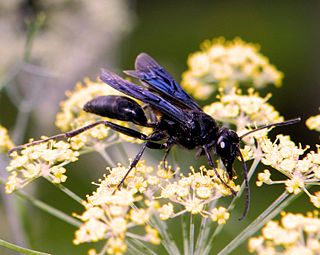
Sphex pensylvanicus, the great black wasp, is a species of digger wasp. It lives across most of North America and grows to a size of 20–35 mm (0.8–1.4 in). The larvae feed on living insects that the females paralyze and carry to the underground nest.
In the 10th edition of Systema Naturae, Carl Linnaeus classified the arthropods, including insects, arachnids and crustaceans, among his class "Insecta". Insects with membranous wings, including bees, wasps and ants were brought together under the name Hymenoptera.

Commemoration of Carl Linnaeus has been ongoing for over two centuries. Celebrated for his scientific work, Linnaeus was knighted and granted nobility in life. After his death, he has been featured in sculpture, on postage stamps and banknotes, as well as by a medal from the eponymous Linnean Society of London. Several notable people have the given names Linnaeus/Linné or Linnea/Linnéa. Among other things named in his honor are plants, astronomical features, towns, an arboretum, a mineral and a university.

Scolia is a genus of scoliid wasps in the subfamily Scoliinae. There are over 200 described species in Scolia.
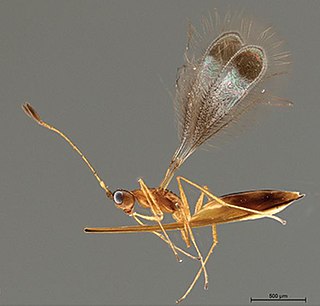
Polynema is a genus of fairyflies or fairy wasps, insects in the family Mymaridae.
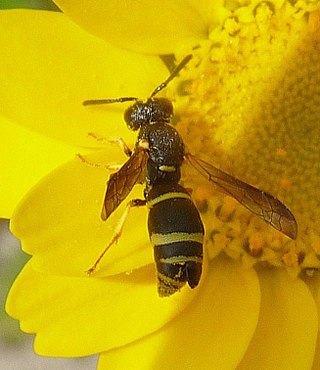
Odynerus spinipes, the spiny mason wasp, is a species of potter wasp from western Europe. It is the type species of the genus Odynerus, being first described by Carl Linnaeus in his landmark 1758 10th edition of Systema Naturae.
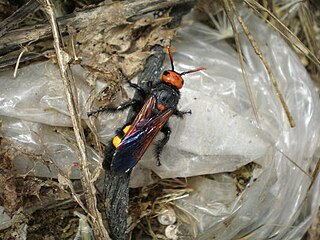
Megascolia is a genus of large solitary wasps from the family Scoliidae, the species classified under Megascolia include some of the world's largest wasps. They are parasitoids of large Scarabeid beetles such as the European rhinoceros beetle Oryctes nasicornis and Atlas beetle Chalcosoma atlas.
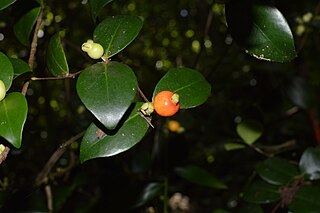
Eugenia palumbis is a shrub with edible fruits in the family Myrtaceae. It is endemic to the Mariana Islands, including Guam and the Commonwealth of the Northern Mariana Islands.

Stethaspis is a genus of beetles in the family Scarabaeidae, subfamily Melolonthinae.
